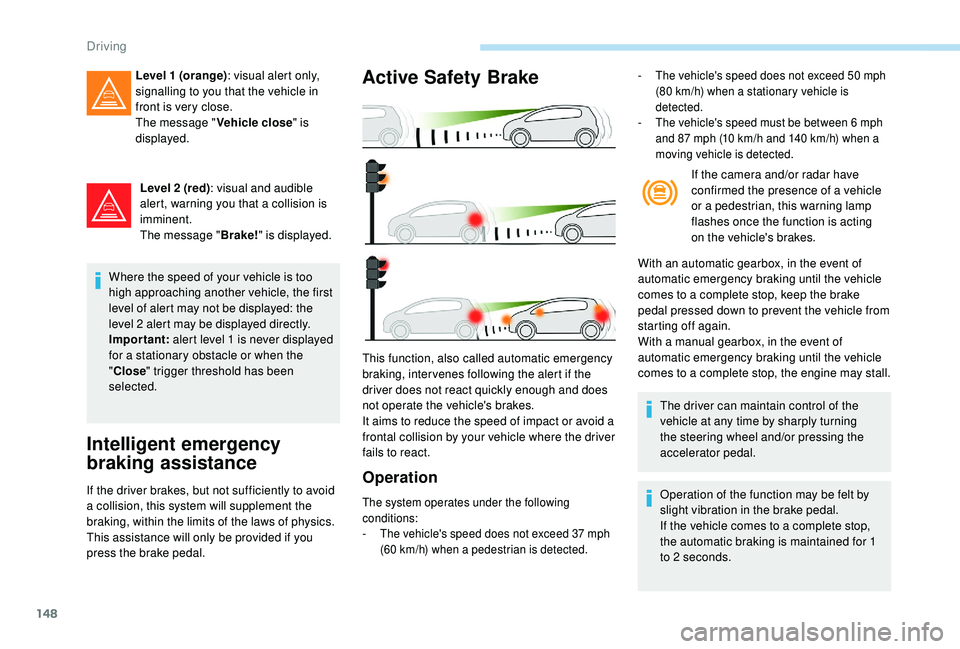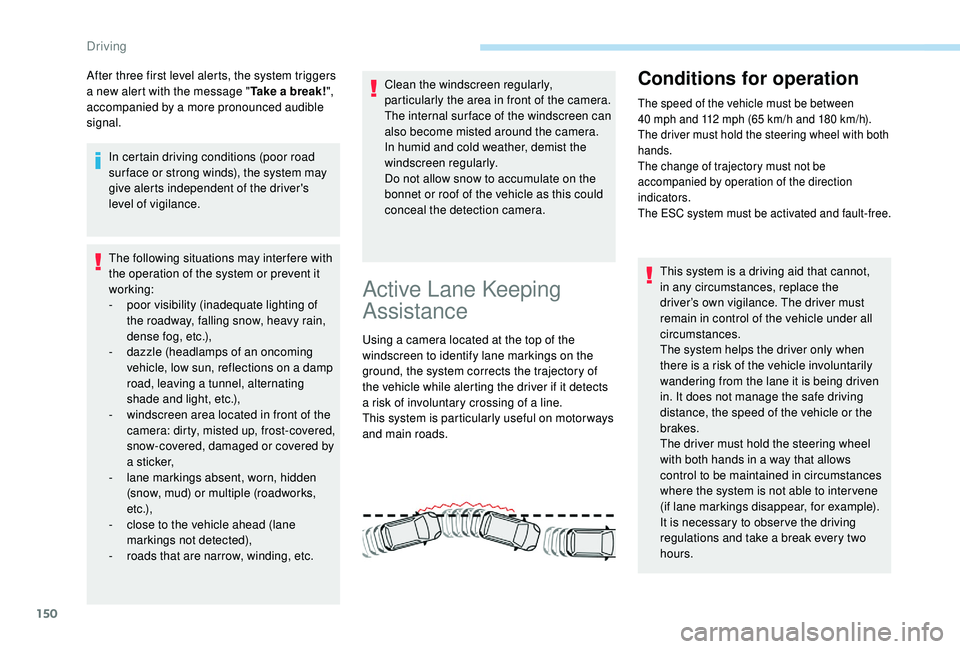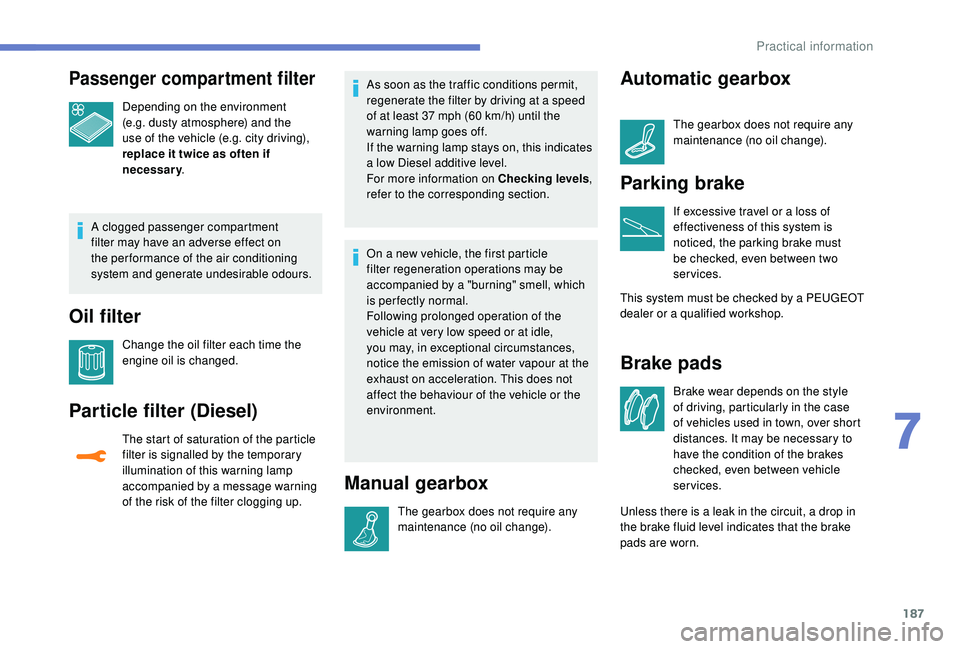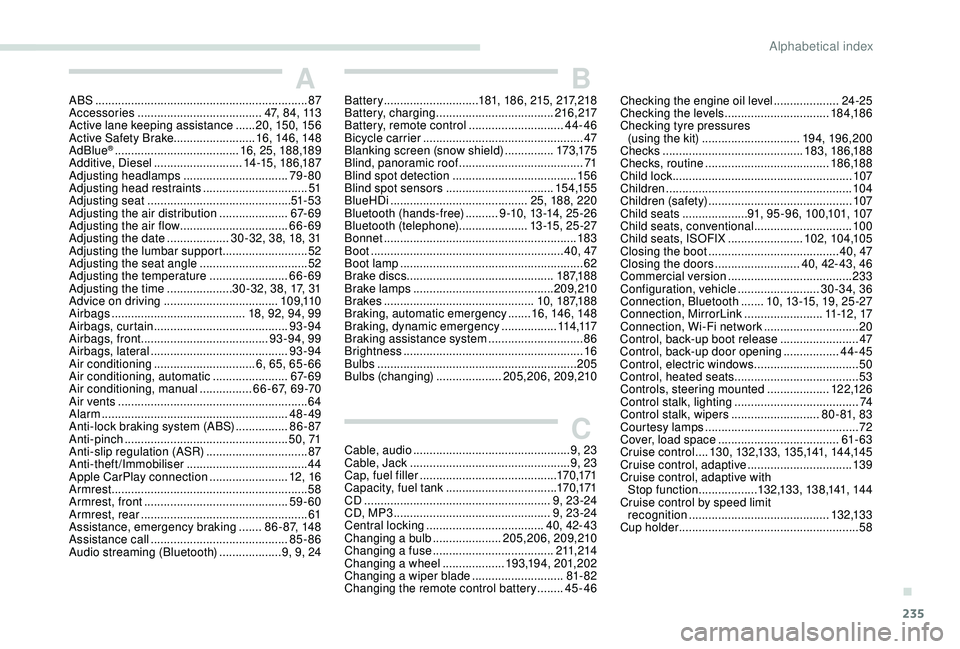2018 Peugeot 308 brakes
[x] Cancel search: brakesPage 150 of 324

148
Level 2 (red): visual and audible
alert, warning you that a collision is
imminent.
The message " Brake!" is displayed.
Where the speed of your vehicle is too
high approaching another vehicle, the first
level of alert may not be displayed: the
level 2 alert may be displayed directly.
Important: alert level 1 is never displayed
for a stationary obstacle or when the
" Close " trigger threshold has been
selected.
Intelligent emergency
braking assistance
If the driver brakes, but not sufficiently to avoid
a collision, this system will supplement the
braking, within the limits of the laws of physics.
This assistance will only be provided if you
press the brake pedal.
Active Safety Brake
Operation
- The vehicle's speed does not exceed 50 mph
(80 km/h) when a stationary vehicle is
detected.
-
T
he vehicle's speed must be between 6 mph
and 87
mph (10 km/h and 140 km/h) when a
moving vehicle is detected.
If the camera and/or radar have
confirmed the presence of a vehicle
or a pedestrian, this warning lamp
flashes once the function is acting
on the vehicle's brakes.
With an automatic gearbox, in the event of
automatic emergency braking until the vehicle
comes to a complete stop, keep the brake
pedal pressed down to prevent the vehicle from
starting off again.
With a manual gearbox, in the event of
automatic emergency braking until the vehicle
comes to a complete stop, the engine may stall.
The driver can maintain control of the
vehicle at any time by sharply turning
the steering wheel and/or pressing the
accelerator pedal.
Operation of the function may be felt by
slight vibration in the brake pedal.
If the vehicle comes to a complete stop,
the automatic braking is maintained for 1
to 2
seconds.
This function, also called automatic emergency
braking, inter venes following the alert if the
driver does not react quickly enough and does
not operate the vehicle's brakes.
It aims to reduce the speed of impact or avoid a
frontal collision by your vehicle where the driver
fails to react.
Level 1 (orange)
: visual alert only,
signalling to you that the vehicle in
front is very close.
The message " Vehicle close" is
displayed.
The system operates under the following
conditions:
-
T
he vehicle's speed does not exceed 37 mph
(60
km/h) when a pedestrian is detected.
Driving
Page 152 of 324

150
After three first level alerts, the system triggers
a new alert with the message "Take a break!",
accompanied by a more pronounced audible
signal.
In certain driving conditions (poor road
sur face or strong winds), the system may
give alerts independent of the driver's
level of vigilance.
The following situations may interfere with
the operation of the system or prevent it
working:
-
p
oor visibility (inadequate lighting of
the roadway, falling snow, heavy rain,
dense fog, etc.),
-
d
azzle (headlamps of an oncoming
vehicle, low sun, reflections on a damp
road, leaving a tunnel, alternating
shade and light, etc.),
-
w
indscreen area located in front of the
camera: dirty, misted up, frost-covered,
snow-covered, damaged or covered by
a s t i c ke r,
-
l
ane markings absent, worn, hidden
(snow, mud) or multiple (roadworks,
e t c .),
-
c
lose to the vehicle ahead (lane
markings not detected),
-
r
oads that are narrow, winding, etc. Clean the windscreen regularly,
particularly the area in front of the camera.
The internal sur face of the windscreen can
also become misted around the camera.
In humid and cold weather, demist the
windscreen regularly.
Do not allow snow to accumulate on the
bonnet or roof of the vehicle as this could
conceal the detection camera.
Active Lane Keeping
Assistance
Using a camera located at the top of the
windscreen to identify lane markings on the
ground, the system corrects the trajectory of
the vehicle while alerting the driver if it detects
a risk of involuntary crossing of a line.
This system is particularly useful on motor ways
and main roads.
Conditions for operation
The speed of the vehicle must be between
40
mph and 112 mph (65 km/h and 180 km/h).
The driver must hold the steering wheel with both
hands.
The change of trajectory must not be
accompanied by operation of the direction
indicators.
The ESC system must be activated and fault-free.
This system is a driving aid that cannot,
in any circumstances, replace the
driver’s own vigilance. The driver must
remain in control of the vehicle under all
circumstances.
The system helps the driver only when
there is a risk of the vehicle involuntarily
wandering from the lane it is being driven
in. It does not manage the safe driving
distance, the speed of the vehicle or the
brakes.
The driver must hold the steering wheel
with both hands in a way that allows
control to be maintained in circumstances
where the system is not able to inter vene
(if lane markings disappear, for example).
It is necessary to obser ve the driving
regulations and take a break every two
hours.
Driving
Page 163 of 324

161
Obstacles may appear further away than
they actually are in reality.
It is important to check the sides of the
vehicle during the manoeuvre, using the
mirrors.
The rear parking sensors also provide
information on the vehicle's surroundings.
180° viewRecommendations on care
In bad or wintry weather, ensure that the
sensors and camera are not covered with mud,
ice or snow.
Check the cleanliness of the camera lens
regularly.
If necessary, clean the camera with a soft, dry
cloth.
When washing your vehicle at high pressure,
direct the lance at least 30
cm away from the
camera and parking sensors.
The 180° view facilitates reversing out of a
parking bay, making it possible to see the
approach of vehicles, pedestrians and cyclists.
This view is not recommended for carrying out
a complete manoeuvre. It consists of 3 areas: left A
, centre B and
right C .
This view is available only from the view
selection menu.
Park Assist
This system provides active assistance with
parking: it detects a parking space then
operates the steering system to park in this
space.
With a manual gearbox , the driver manages
the accelerator, brakes, gears and clutch.
With an automatic gearbox (EAT6/EAT8) , the
driver manages the accelerator, brakes and
gears. During phases of entry into and exit from a
parking space, the system provides visual
and audible information to the driver in order
to make the manoeuvres safe. It may be
necessary to move for wards and backwards
more than once.
The driver can take control at any time by
gripping the steering wheel.
This manoeuvring assistance system
cannot, in any circumstances, replace the
need for vigilance on the part of the driver.
The driver must remain in control of their
vehicle ensuring that the space remains
clear throughout the manoeuvre.
In some circumstances, the sensors may
not detect small obstacles located in their
blind spots.
The Park Assist system cannot work with
the engine off.
6
Driving
Page 189 of 324

187
Passenger compartment filter
Depending on the environment
(e.g. dusty atmosphere) and the
use of the vehicle (e.g. city driving),
replace it twice as often if
necessary.
A clogged passenger compartment
filter may have an adverse effect on
the per formance of the air conditioning
system and generate undesirable odours.
Oil filter
Change the oil filter each time the
engine oil is changed.
Particle filter (Diesel)
The start of saturation of the particle
filter is signalled by the temporary
illumination of this warning lamp
accompanied by a message warning
of the risk of the filter clogging up. As soon as the traffic conditions permit,
regenerate the filter by driving at a speed
of at least 37
mph (60 km/h) until the
warning lamp goes off.
If the warning lamp stays on, this indicates
a low Diesel additive level.
For more information on Checking levels ,
refer to the corresponding section.
On a new vehicle, the first particle
filter regeneration operations may be
accompanied by a "burning" smell, which
is per fectly normal.
Following prolonged operation of the
vehicle at very low speed or at idle,
you may, in exceptional circumstances,
notice the emission of water vapour at the
exhaust on acceleration. This does not
affect the behaviour of the vehicle or the
environment.
Manual gearbox
The gearbox does not require any
maintenance (no oil change).
Automatic gearbox
The gearbox does not require any
maintenance (no oil change).
Parking brake
If excessive travel or a loss of
effectiveness of this system is
noticed, the parking brake must
be checked, even between two
services.
This system must be checked by a PEUGEOT
dealer or a qualified workshop.
Brake pads
Brake wear depends on the style
of driving, particularly in the case
of vehicles used in town, over short
distances. It may be necessary to
have the condition of the brakes
checked, even between vehicle
services.
Unless there is a leak in the circuit, a drop in
the brake fluid level indicates that the brake
pads are worn.
7
Practical information
Page 190 of 324

188
Brake disc/drum wear
For information on checking
brake disc/drum wear, contact a
PEUGEOT dealer or a qualified
workshop.
Electric parking brake
This system does not require any
specific check. However, in the
event of a problem, have the system
checked by a PEUGEOT dealer or a
qualified workshop.
For more information on the Electric
parking brake , refer to the corresponding
section.
Wheels and tyres
The pressure must be checked on
all tyres, including the spare wheel,
when the tyres are "cold", at least
once a month and before a long
j o u r n ey. The pressures given on the tyre pressure label
are valid for "cold" tyres. If you have driven for
more than 10
minutes or more than 6 miles
(10 kilometres) at more than 31 mph (50 km/h),
0.3 bar (30 kPa) should be added to the values
given on the label.
Under-inflation increases fuel consumption.
Non-compliant tyre pressure causes premature
wear on tyres and has an adverse effect on the
vehicle's road holding – Risk of an accident!
Driving with worn or damaged tyres reduces
braking efficiency and control of the vehicle's
steering. Regular inspections of the condition
of tyres (tread and sides) and rims are
recommended as well as making sure that
valves are fitted.
Using different size wheels and tyres from
those specified can affect the lifetime of tyres,
wheel rotation, ground clearance and the
speedometer reading and have an adverse
effect on road holding.
Fitting different tyres on the front and rear axles
can cause the ESC to mistime. Only use products recommended by
PEUGEOT or products of equivalent
quality and specification.
In order to optimise the operation of
components as important as those in the
braking system, PEUGEOT selects and
offers very specific products.
After washing the vehicle, dampness, or
in wintry conditions, ice can form on the
brake discs and pads: braking efficiency
may be reduced. Make light brake
applications to dry and defrost the brakes.
AdBlue® (BlueHDi
engines)
To respect the environment and ensure
compliance with the Euro 6 standard, without
adversely affecting the per formance or fuel
consumption of its Diesel engines, PEUGEOT
has taken the decision to equip its vehicles
with a system that associates SCR (Selective
Catalytic Reduction) with a Diesel particle filter
(DPF) for the treatment of exhaust gases.
SCR system
Using a fluid called AdBlue® containing urea,
a catalytic converter converts up to 85%
of nitrogen oxides (NOx) into nitrogen and
water, which are harmless to health and the
environment.
Practical information
Page 313 of 324

235
AABS .................................................................87
Accessories ...................................... 47, 84, 113
Active lane keeping assistance
......20, 15 0, 15 6
Active Safety Brake......................... 16, 14 6, 148
AdBlue
® ...................................... 1 6, 25, 188,189
Additive, Diesel ........................... 14 -15, 18 6,187
Adjusting headlamps
................................ 79-80
Adjusting head restraints
................................ 51
Adjusting seat
............................................ 51- 5 3
Adjusting the air distribution
.....................67- 6 9
Adjusting the air flow
................................. 6
6-69
Adjusting the date
................... 30 -32, 38, 18, 31
Adjusting the lumbar support
.......................... 52
A
djusting the seat angle
................................. 52
Adjusting the temperature
........................66-69
Adjusting the time
.................... 30 -32, 38, 17, 31
Advice on driving
................................... 109,110
Airbags
...............................
..........18, 92, 94, 99
Airbags, curtain
......................................... 93-94
Airbags, front ....................................... 93 -94, 99
Airbags, lateral
.......................................... 93-94
Air conditioning
............................... 6, 65, 65 - 66
Air conditioning, automatic
.......................67- 6 9
Air conditioning, manual
................ 6
6-67, 69-70
Air vents
.......................................................... 64
Alarm
......................................................... 48-49
Anti-lock braking system (ABS)
................86 - 87
Anti-pinch
.................................................. 5
0, 71
Anti-slip regulation (ASR)
............................... 87
Anti-theft/Immobiliser
..................................... 44
Apple CarPlay connection
........................12, 16
Armrest
................
............................................ 58
Armrest, front
............................................ 59-60
Armrest, rear
...............................
....................61
Assistance, emergency braking
.......86 - 87, 148
Assistance call
...............................
...........85-86
Audio streaming (Bluetooth)
...................9, 9, 24
BBattery ............................. 181, 18 6, 215, 217, 218
Battery, charging .................................... 216,217
Battery, remote control
.............................44-46
Bicycle carrier
...............................
..................47
Blanking screen (snow shield)
...............173 ,175
Blind, panoramic roof
...................................... 71
Blind spot detection
...................................... 15 6
Blind spot sensors
................................. 15 4,15 5
BlueHDi
.......................................... 25, 188, 220
Bluetooth (hands-free)
.......... 9
-10, 13 -14, 25 -2 6
Bluetooth (telephone)
..................... 1
3 -15, 25 -27
Bonnet
........................................................... 183
Boot
........................................................... 40, 47
Boot lamp
........................................................ 62
Brake discs
............................................. 187,188
Brake lamps
...............................
............209,210
Brakes
.............................................. 10, 187,188
Braking, automatic emergency
.......16, 14 6, 148
Braking, dynamic emergency
.................114 ,117
Braking assistance system
.............................86
Brightness
....................................................... 16
Bulbs
............................................................. 205
Bulbs (changing)
....................205,206, 209,210
CCable, audio ................................................ 9, 23
Cable, Jack ................................................. 9, 23
Cap, fuel filler
...............................
...........170,171
Capacity, fuel tank
.................................. 170,171
CD
......................................................... 9, 23 -24
CD, MP3
................................................ 9, 23 -24
Central locking
.................................... 4
0, 42- 43
Changing a bulb
..................... 20
5,206, 209,210
Changing a fuse
..................................... 21
1,214
Changing a wheel
................... 19
3,19 4, 201, 202
Changing a wiper blade
............................ 81
- 82
Changing the remote control battery
........45-46 Checking the engine oil level
....................
24-25
Checking the levels
................................
18 4,18 6
Checking tyre pressures (using the kit)
..............................
19 4, 19 6, 20 0
Checks
...........................................
183, 18 6,188
Checks, routine
......................................
18 6,188
Child lock
.......................................................
107
Children
.........................................................
104
Children (safety)
............................................
107
Child seats
.................... 9
1, 95 - 9 6, 10 0,101, 107
Child seats, conventional
..............................
10 0
Child seats, ISOFIX .......................
102, 104,105
Closing the boot
........................................
4
0, 47
Closing the doors
..........................
40, 42- 43, 46
Commercial version
......................................
233
Configuration, vehicle
......................... 3
0-34, 36
Connection, Bluetooth
....... 1
0, 13 -15, 19, 25 -27
Connection, MirrorLink
........................
11 -12 , 17
Connection, Wi-Fi network
.............................
20
Control, back-up boot release ........................
47
Control, back-up door opening .................
44-45
Control, electric windows
................................
50
Control, heated seats
......................................
53
Controls, steering mounted
...................
12 2,126
Control stalk, lighting
......................................
74
Control stalk, wipers
...........................
8
0 - 81, 8 3
Courtesy lamps ...............................................
72
Cover, load space .....................................
61- 63
Cruise control ....13 0, 132,13 3, 13 5,141, 14 4,14 5
Cruise control, adaptive
................................13 9
Cruise control, adaptive with Stop function
..................132,13 3, 13 8,141, 14 4
Cruise control by speed limit recognition
...............................
............132,13 3
Cup holder
.......................................................58
.
Alphabetical index